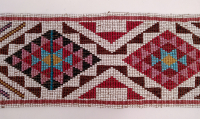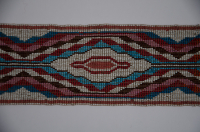Bandolier Strap
Bandolier Strap
Bandolier Strap

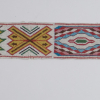
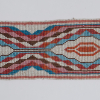
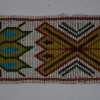
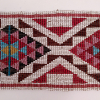
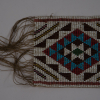
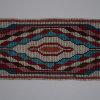
Loom-woven beadwork on a white field, geometric design with diamonds, triangles, and arrows
Summary of catalogue records
Read More About This Relative
Thread, cotton?, tan; Seed beads, glass, opaque white, opaque black, transparent medium brown, red (opaque dusty rose, transparent dusty rose, opaque rose, transparent rose), opaque coral orange, opaque lemon yellow, opaque pear green, blue (opaque sky, opaque azure).
Handmade; Loom-woven beadwork (single warp, double weft); Geometric bead designs clearly shows a division at half-way mark of strap; One half has a number of detached geometric figures, other half has a continuous flow of shapes.
Geometric, diamond, triangle, arrow, St. Andrews cross, chevron, otter tail
Bandolier bags most likely originated in the Upper Great Lakes region during the 1840s and 1850s. Fashioned exclusively from European materials and adorned with thousands of beads, bandolier bags were primarily for show, as a symbol of identity, wealth and status. Although initially functional, by the late 19th and early 20th centuries many of the bags had false pockets or none at all. Sometimes called "friendship bags", they were often created as gifts to strengthen relationships within communities or between nations. By the 1870s they had become an important element of formal dress worn mainly at ceremonies and celebrations by men, and occasionally by women. They wore them - singly or several at a time - crossed over the torso or draped around the neck. “The wearing of more than one bag was generally the prerogative of a leader or a person of high honour." (McCord, 2013) “Bandoliers were adopted by Ojibwa in 19th century after seeing bullet pouches used by British soldiers. Bullet pouches were plain and decorated with crest or coat of arms. When idea adopted by Ojibwa, they were greatly prized and highly decorated ceremonial accessories. They became so highly prized by Ojibwa and other tribes (especially Sioux), that one bandolier could be traded for one pony. They became a status symbol of highest ranking Midewiwin priests. (Flanders, 1977)
Provenance
McCord Museum, Wearing Our Identity. Montreal: The McCord Museum, 2013; and “Beads: Their Use By Upper Great Lakes Indians” by Richard Flanders, 1977
McCord Museum. Wearing Our Identity. Montreal: The McCord Museum, 2013. Print.
About This GRASAC Record
Manitoba Museum
Content from the Manitoba Museum's catalog records. Uploaded by Orvis Starkweather as part of their summer internship.













attributed to Northeast Great Lakes-Riverine
 Knowledge Sharing Platform
Knowledge Sharing Platform




